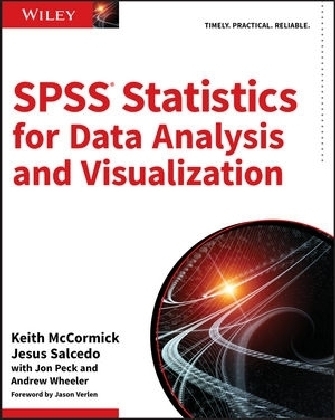
SPSS Statistics for Data Analysis and Visualization
John Wiley & Sons (Verlag)
978-1-119-00355-7 (ISBN)
- Titel ist leider vergriffen;
keine Neuauflage - Artikel merken
IBM SPSS Statistics is complex: true mastery requires a deep understanding of statistical theory, the user interface, and programming. Most users don't encounter all of the methods SPSS offers, leaving many little-known modules undiscovered. This book walks you through tools you may have never noticed, and shows you how they can be used to streamline your workflow and enable you to produce more accurate results.
Conduct a more efficient and accurate analysis
Display complex relationships and create better visualizations
Model complex interactions and master predictive analytics
Integrate R and Python with SPSS Statistics for more efficient, more powerful code
These "hidden tools" can help you produce charts that simply wouldn't be possible any other way, and the support for other programming languages gives you better options for solving complex problems.
If you're ready to take advantage of everything this powerful software package has to offer, SPSS Statistics for Data Analysis and Visualization is the expert-led training you need.
Keith McCormick is a data mining consultant, trainer, and speaker. A passionate user of SPSS for 25 years, he has trained thousands on how to effectively use SPSS Statistics and SPSS Modeler. He blogs at keithmccormick.com.
Jesus Salcedo is an independent statistical consultant. He is a former SPSS Curriculum Team Lead and Senior Education Specialist who has written numerous SPSS training courses and trained thousands of users. JON PECK, now retired from IBM, was a senior engineer, statistician, and product strategist for SPSS and IBM for 32 years. He designed and contributed to many features of SPSS Statistics and has consulted with and trained many users. He remains active on social media.
Andrew Wheeler is a researcher in criminal justice and a former crime analyst. He has used SPSS for over 8 years, and often blogs SPSS tutorials at andrewpwheeler.wordpress.com
Foreword xxiii
Introduction xxvii
Part I Advanced Statistics 1
Chapter 1 Comparing and Contrasting IBM SPSS AMOS with Other Multivariate Techniques 3
T-Test 7
ANCOVA 8
MANOVA 13
Factor Analysis and Unobserved Variables in SPSS 23
AMOS 26
Revisiting Factor Analysis and a General Orientation to AMOS 26
The General Model 29
Chapter 2 Monte Carlo Simulation and IBM SPSS Bootstrapping 43
Monte Carlo Simulation 44
Monte Carlo Simulation in IBM SPSS Statistics 44
Creating an SPSS Model File 45
IBM SPSS Bootstrapping 59
Proportions 63
Bootstrap Mean 66
Bootstrap and Linear Regression 68
Chapter 3 Regression with Categorical Outcome Variables 71
Regression Approaches in SPSS 72
Logistic Regression 73
Ordinal Regression Theory 74
Assumptions of Ordinal Regression Models 77
Ordinal Regression Dialogs 77
Ordinal Regression Output 81
Categorical Regression Theory 86
Assumptions of Categorical Regression Models 87
Categorical Regression Dialogs 87
Categorical Regression Output 93
Chapter 4 Building Hierarchical Linear Models 101
Overview of Hierarchical Linear Mixed Models 102
A Two-Level Hierarchical Linear Model Example 102
Mixed Models Linear 104
Mixed Models Linear (Output) 113
Mixed Models Generalized Linear 116
Mixed Models Generalized Linear (Output) 120
Adjusting Model Structure 126
Part II Data Visualization 129
Chapter 5 Take Your Data Visualizations to the Next Level 131
Graphics Options in SPSS Statistics 132
Understanding the Revolutionary Approach in The Grammar of Graphics 136
Bar Chart Case Study 138
Bubble Chart Case Study 143
Chapter 6 The Code Behind SPSS Graphics: Graphics Production Language 147
Introducing GPL: Bubble Chart Case Study 147
GPL Help 155
Bubble Chart Case Study Part Two 156
Double Regression Line Case Study 160
Arrows Case Study 163
MBTI Bubble Chart Case Study 167
Chapter 7 Mapping in IBM SPSS Statistics 173
Creating Maps with the Graphboard Template Chooser 174
Creating a Choropleth of Counts Map 175
Creating Other Map Types 179
Creating Maps Using Geographical Coordinates 185
Chapter 8 Geospatial Analytics 193
Geospatial Association Rules 194
Case Study: Crime and 311 Calls 194
Spatio-Temporal Prediction 207
Case Study: Predicting Weekly Shootings 207
Chapter 9 Perceptual Mapping with Correspondence Analysis, GPL, and OMS 217
Starting with Crosstabs 220
Correspondence Analysis 224
Multiple Correspondence Analysis 234
Crosstabulations 234
Applying OMS and GPL to the MCA Perceptual Map 242
Chapter 10 Display Complex Relationships with Multidimensional Scaling 249
Metric and Nonmetric Multidimensional Scaling 251
Nonmetric Scaling of Psychology Sub ]Disciplines 251
Multidimenional Scaling Dialog Options 253
Multidimensional Scaling Output Interpretation 259
Subjective Approach to Dimension Interpretation 264
Statistical Approach to Dimension Interpretation 266
Part III Predictive Analytics 271
Chapter 11 SPSS Statistics versus SPSS Modeler: Can I Be a Data Miner Using SPSS Statistics? 275
What Is Data Mining? 275
What Is IBM SPSS Modeler? 276
Can Data Mining Be Done in SPSS Statistics? 278
Hypothesis Testing, Type I Error, and Hold-Out Validation 280
Significance of the Model and Importance of Each Independent Variable 284
The Importance of Finding and Modeling Interactions 284
Classic and Important Data Mining Tasks 287
Partitioning and Validating 288
Feature Selection 291
Balancing 294
Comparing Results from Multiple Models 295
Creating Ensembles 297
Scoring New Records 300
Chapter 12 IBM SPSS Data Preparation 303
Identify Unusual Cases 304
Identify Unusual Cases Dialogs 305
Identify Unusual Cases Output 311
Optimal Binning 315
Optimal Binning Dialogs 316
Optimal Binning Output 321
Chapter 13 Model Complex Interactions with IBM SPSS Neural Networks 325
Why Neural Nets? 326
The Famous Case of Exclusive OR and the Perceptron 328
What Is a Hidden Layer and Why Is It Needed? 332
Neural Net Results with the XOR Variables 333
How the Weights Are Calculated: Error Backpropagation 337
Creating a Consistent Partition in SPSS Statistics 340
Comparing Regression to Neural Net with the Bank Salary Case Study 341
Calculating Mean Absolute Percent Error for Both Models 344
Classification with Neural Nets Demonstrated with the Titanic Dataset 349
Chapter 14 Powerful and Intuitive: IBM SPSS Decision Trees 355
Building a Tree with the CHAID Algorithm 355
Review of the CHAID Algorithm 360
Adjusting the CHAID Settings 363
CRT for Classification 366
Understanding Why the CRT Algorithm Produces a Different Tree 368
Missing Data 369
Changing the CRT Settings 369
Comparing the Results of All Four Models 371
Alternative Validation Options 373
The Scoring Wizard 374
Chapter 15 Find Patterns and Make Predictions with K Nearest Neighbors 379
Using KNN to Find Neighbors 380
The Titanic Dataset and KNN Used as a Classifier 381
The Trade-Offs between Bias and Variance 386
Comparing Our Models: Decision Trees, Neural Nets, and KNN 388
Building an Ensemble 391
Part IV Syntax, Data Management, and Programmability 393
Chapter 16 Write More Effi cient and Elegant Code with SPSS Syntax Techniques 395
A Syntax Primer for the Uninitiated 396
Making the Connection: Menus and the Grammar of Syntax 401
What Is Inefficient Code? 403
The Case Study 404
Customer Dataset 406
Fixing the ZIP Codes 407
Addressing Case Sensitivity of City Names with UPPER() and LOWER() 409
Parsing Strings and the Index Function 410
Aggregate and Restructure 410
Pasting Variable Names, TO, Recode, and Count 412
DO REPEAT Spend Ratios 414
Merge 415
Final Syntax File 417
Chapter 17 Automate Your Analyses with SPSS Syntax and the Output Management System 421
Overview of the Output Management System 422
Running OMS from Menus 423
Contents xxi
Automatically Writing Selected Categories of Output to Different Formats 424
Suppressing Output 429
Working with OMS data 436
Running OMS from Syntax 438
Chapter 18 Statistical Extension Commands 441
What Is an Extension Command? 441
TURF Analysis Designing Product Bundles 444
Large Problems 449
Quantile Regression Predicting Airline Delays 450
Comparing Ordinary Least Squares with Quantile Regression Results 455
Operational Considerations 459
Support Vector Machines Predicting Loan Default 461
Background 461
An Example 464
Operational Issues 467
Computing Cohen s d Measure of Effect Size for a T-Test 468
Index 473
| Erscheint lt. Verlag | 20.6.2017 |
|---|---|
| Verlagsort | New York |
| Sprache | englisch |
| Maße | 188 x 232 mm |
| Gewicht | 874 g |
| Einbandart | kartoniert |
| Themenwelt | Informatik ► Datenbanken ► Data Warehouse / Data Mining |
| Mathematik / Informatik ► Mathematik ► Computerprogramme / Computeralgebra | |
| Mathematik / Informatik ► Mathematik ► Statistik | |
| Schlagworte | Big Data • Data Analysis • Data Visualization • Datenanalyse • Datenvisualisierung • SPSS |
| ISBN-10 | 1-119-00355-5 / 1119003555 |
| ISBN-13 | 978-1-119-00355-7 / 9781119003557 |
| Zustand | Neuware |
| Haben Sie eine Frage zum Produkt? |
aus dem Bereich


